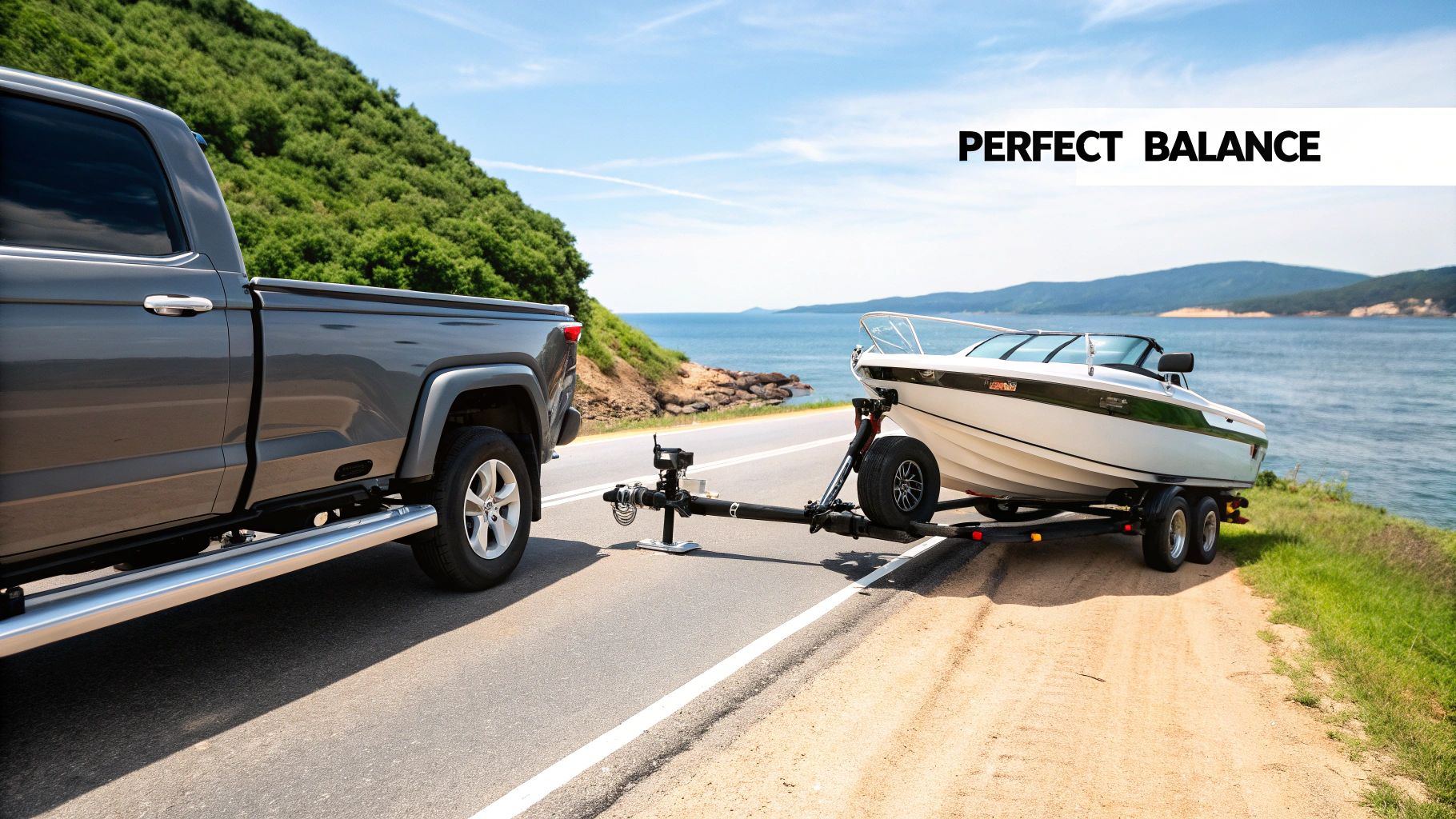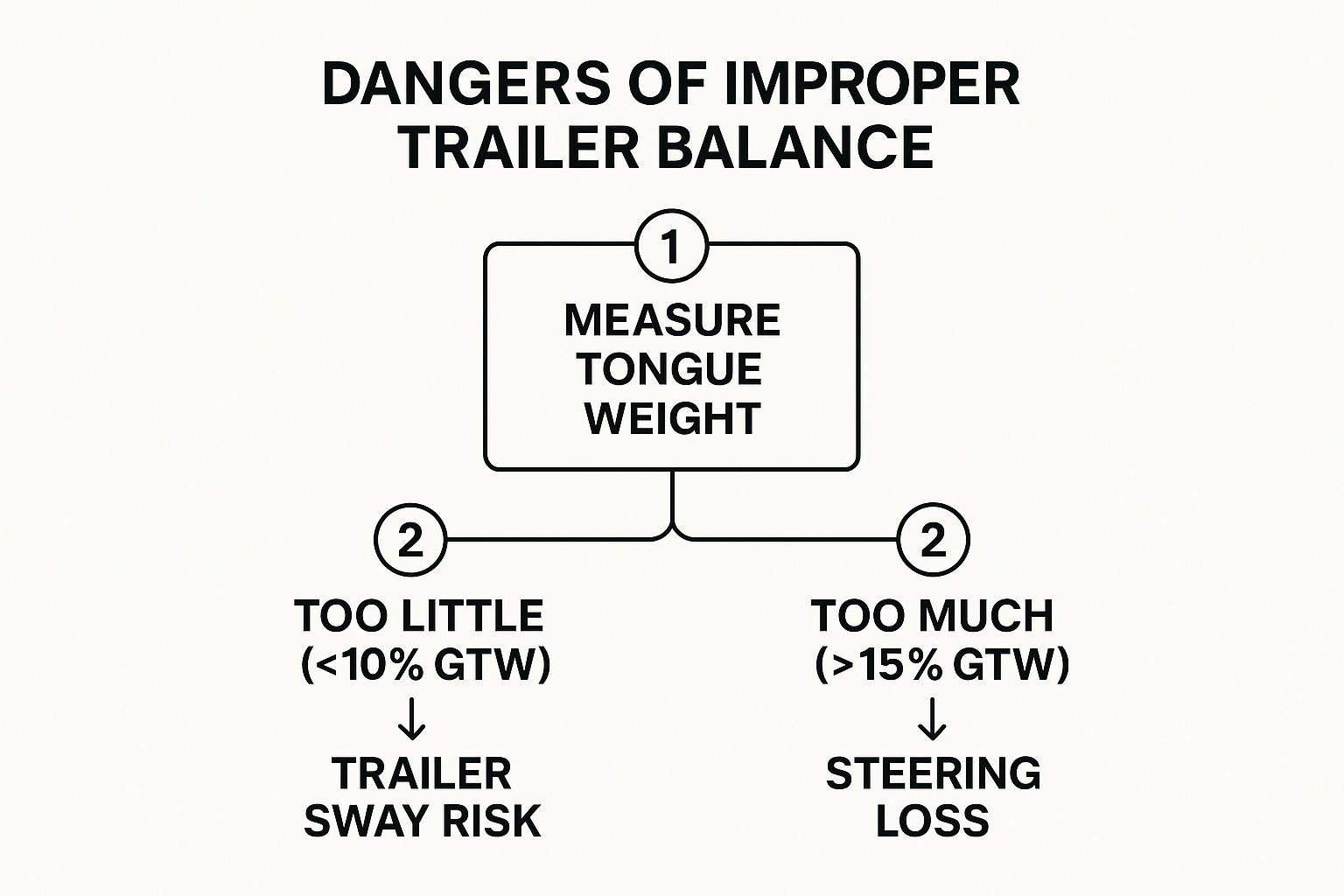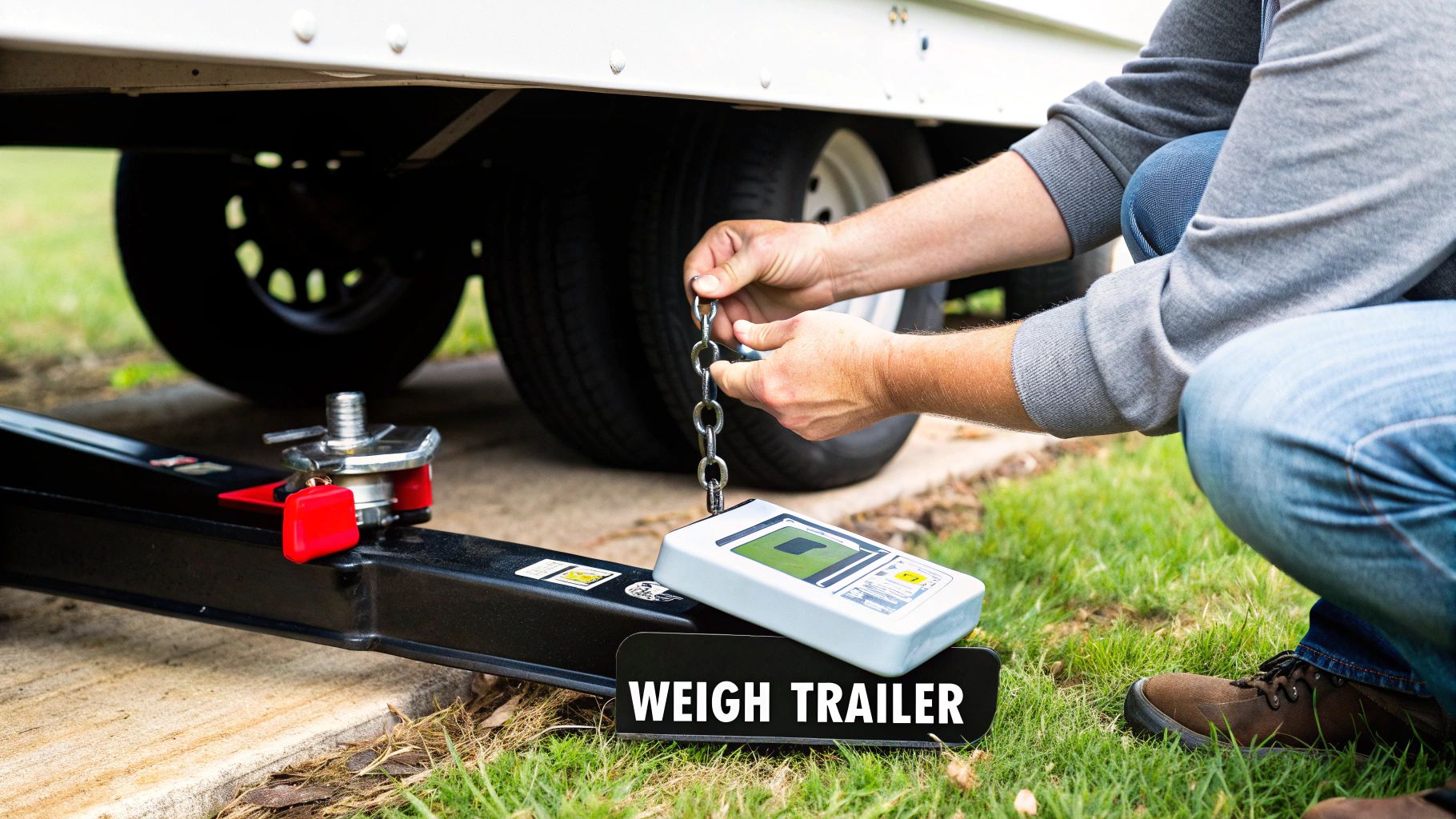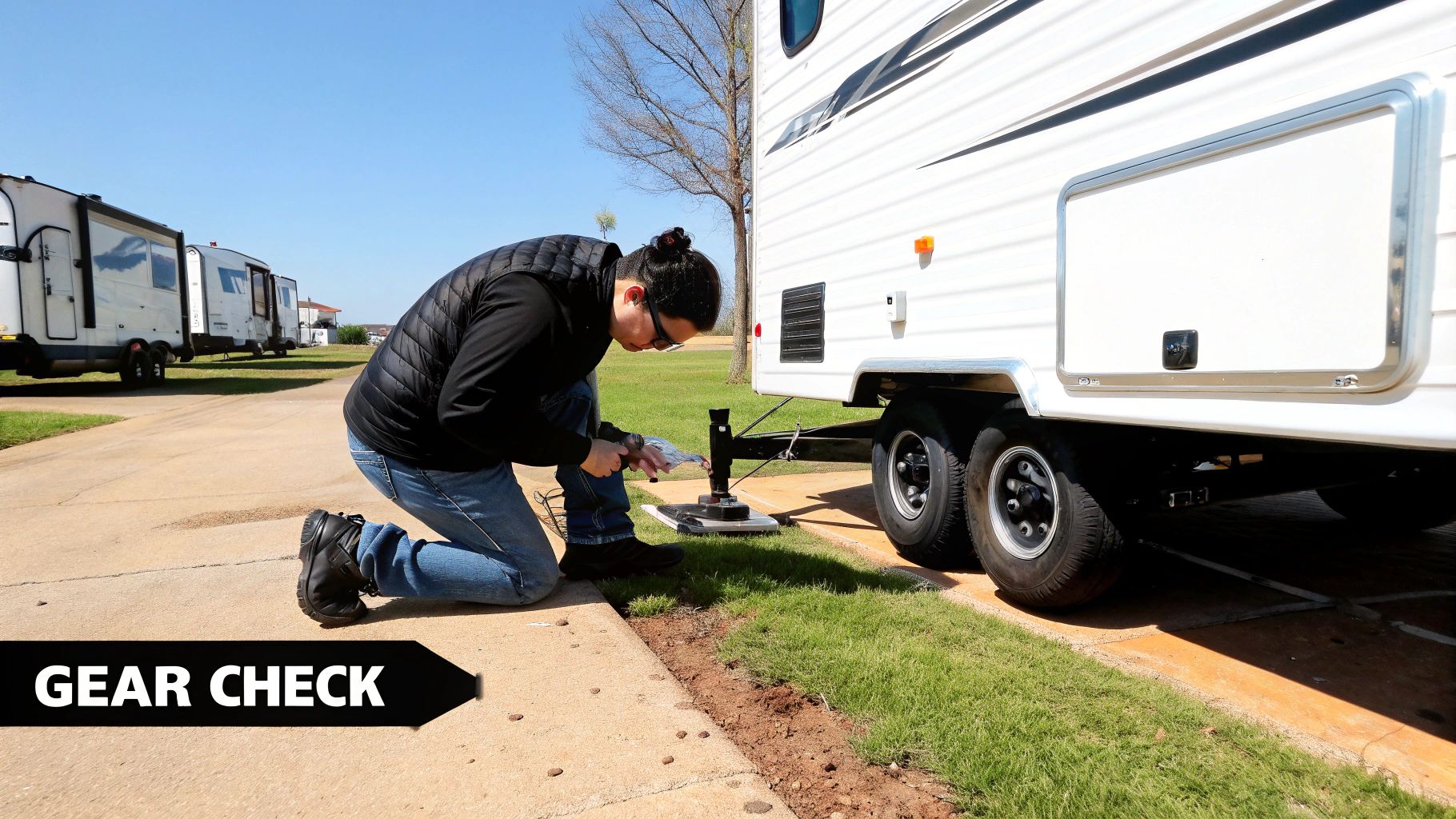Boat Trailer Tongue Weight Explained for Safer Towing
Think of your tow vehicle and trailer rig like a seesaw. Get the balance wrong, and things get tippy and unpredictable. That's where boat trailer tongue weight comes in—it's the downward force your fully loaded trailer puts on the hitch ball. Nailing this one measurement is pretty much the secret to keeping that seesaw perfectly balanced on the highway.
It’s easily the most important factor for a safe, stable, and stress-free tow.
Why Tongue Weight Is the Key to Safe Towing

Ever tried pushing a wheelbarrow with almost nothing in it? The front wheel gets light and twitchy, making it a pain to steer. Now, picture that same wheelbarrow overloaded, pushing down so hard you can barely lift the handles. Both situations are awkward and unsafe. That’s exactly what happens to your truck or SUV when the trailer’s tongue weight is off.
When you get the tongue weight right, your tow vehicle and trailer act like one solid, predictable unit. It plants the rear tires of your vehicle firmly on the pavement, giving you the grip you need for confident steering, smooth acceleration, and solid braking. The whole setup just feels right, even when a big rig blows by or a crosswind hits you on an open stretch of road.
The Physics of a Balanced Load
It really all comes down to proper weight distribution. A well-balanced trailer setup is your best defense against some seriously scary situations that can lead to a total loss of control.
Here’s what a properly balanced load does for you:
- Improves Steering Control: It keeps enough weight pressed down on your vehicle’s front axle, ensuring the front tires stay glued to the road for precise steering.
- Makes Braking Effective: A balanced load ensures all the tires—on both your vehicle and the trailer—are doing their fair share of the work to stop you. This is a huge deal for getting the most out of your boat trailer brakes.
- Prevents Trailer Sway: This is the big one. Correct tongue weight is your number one weapon against terrifying trailer sway, where the trailer starts fishtailing wildly behind you.
Finding the Sweet Spot
So, what's the magic number? The goal is to get your tongue weight to be a specific percentage of your total loaded trailer weight, which is known as the Gross Trailer Weight (GTW).
To help you visualize the right targets, here’s a quick reference guide. You'll notice boat trailers have a slightly different ideal range than other common trailer types.
Ideal Tongue Weight Quick Reference Guide
| Trailer Type | Recommended Tongue Weight (% of Total Trailer Weight) | Example (5,000 lb Total Weight) |
|---|---|---|
| Boat Trailers | 6% – 10% | 300 lbs – 500 lbs |
| Travel Trailers | 10% – 15% | 500 lbs – 750 lbs |
| Cargo/Utility Trailers | 10% – 15% | 500 lbs – 750 lbs |
| Car Haulers | 10% – 15% | 500 lbs – 750 lbs |
The reason for the slightly lower percentage for boats is that big, heavy outboard engine hanging off the back. Since that weight is already positioned behind the trailer's axle, it requires a different balance point to keep things stable.
The proper management of trailer tongue weight is crucial for safe and efficient towing. In most scenarios, a tongue weight of 10 to 15 percent of the total trailer weight is considered ideal, though this can shift to 6 to 10 percent for motorized boats due to the engine's aft position.
Getting this simple calculation right is the first and most vital step toward a safer towing experience every single time you head to the ramp.
The Dangers of Improper Trailer Balance
Getting your trailer's tongue weight wrong is a much bigger deal than a simple mistake—it can create some seriously dangerous situations, especially at highway speeds. An unbalanced trailer doesn't just feel a bit off; it actively fights against you, turning a normal drive into a white-knuckle ride. The two main culprits, too much and too little tongue weight, each bring their own unique set of risks to you, your boat, and everyone else sharing the road.
This chart breaks down the two scary outcomes of getting your trailer balance wrong.

The bottom line is that both extremes—dropping below 10% or going over 15% of your GTW—can lead straight to losing control of your vehicle, just for different mechanical reasons.
Too Little Tongue Weight: The Pendulum Effect
When your tongue weight is too light (less than 10% of your GTW), the trailer's center of gravity gets pushed too far back, behind the axle. This setup essentially turns your boat and trailer into a giant pendulum, just waiting for the smallest nudge to start swinging out of control.
Picture this: you're cruising down the highway and a semi-truck rumbles past. That gust of wind is all it takes to kick off trailer sway, a terrifying side-to-side motion that can escalate in a heartbeat. The trailer starts "wagging the dog," shoving the back of your tow vehicle from side to side and completely overpowering your steering. In a worst-case scenario, the whole rig can jackknife or even roll over.
An improperly balanced trailer with not enough tongue weight is one of the top causes of sway-related accidents. The forces at play can easily overwhelm a driver's ability to correct, leading to a total loss of control.
Too Much Tongue Weight: A Dangerous Lever
On the flip side, when the tongue weight is too heavy (more than 15% of your GTW), it acts like a giant lever, prying the front end of your tow vehicle right off the pavement. All that excessive downward force on the hitch ball crushes your rear suspension and lifts critical weight off your front axle.
This triggers a whole cascade of safety failures:
- Loss of Steering: With less weight pinning them to the road, your front tires lose their grip. Your steering will suddenly feel light, mushy, and unresponsive, making it tough to handle curves or swerve around an obstacle.
- Compromised Braking: Your vehicle's front brakes do most of the heavy lifting when it comes to stopping. When the front end is lifted, their effectiveness plummets, which means your stopping distance in an emergency gets a whole lot longer.
- Overheating Rear Tires: Those poor rear tires are now overloaded and can easily overheat and fail under all that extra strain.
Both of these scenarios make it crystal clear why measuring and adjusting your boat trailer tongue weight isn't just a "best practice." It's a non-negotiable step for towing safely.
How to Measure Tongue Weight Accurately

Knowing your target numbers is one thing, but getting an actual measurement is where the real work begins. Just guessing your boat trailer tongue weight is asking for trouble, plain and simple. Thankfully, you don't have to be an engineer to get a solid reading.
There are a few different ways to find out exactly how much downward force your trailer is putting on your hitch. Before you start with any method, make sure your boat and trailer are loaded up exactly as they would be for a trip—that means coolers, fuel, anchors, lines, fenders, the whole nine yards. This is the only way to get a true number.
Using a Dedicated Tongue Weight Scale
For the simplest and most direct measurement you can do at home, nothing beats a dedicated trailer tongue weight scale. These tools are built for one job and one job only, so they give you a highly accurate reading without any math or complicated setups.
It’s about as straightforward as it gets:
- Make sure your trailer is on level ground and unhitched from your truck.
- Chock the trailer wheels so it can’t roll anywhere.
- Pop the scale right under the trailer coupler.
- Use the trailer’s tongue jack to slowly lower the coupler onto the scale until the scale is holding all the weight.
- Read the number on the display. That’s it.
This method takes all the guesswork out of the equation. It's the best option for boaters who are constantly changing their gear layout or just want precise, repeatable measurements every time.
The DIY Bathroom Scale Method
Don’t have a special scale? No problem. For smaller, lighter boats, you can get a surprisingly accurate reading with a regular bathroom scale and a little high school physics. This trick works great for setups where you expect the tongue weight to be under 300-400 pounds.
Important Safety Note: Never, ever put the trailer tongue directly on a bathroom scale. Most scales aren't built for that kind of concentrated weight and you'll destroy it. The lever method described here spreads the load safely.
Here’s how you pull it off:
- Set a bathroom scale on the ground. Three feet away, place a sturdy block, like a brick or a solid piece of wood.
- Lay a strong pipe or a 4x4 beam across both the scale and the block to create a simple lever.
- Position the beam so the spot where the trailer coupler will rest is exactly one foot from the block and two feet from the scale.
- Carefully lower the trailer tongue onto the beam at that one-foot mark.
- Check the weight on the scale and multiply it by three.
That 3:1 ratio gives you your real boat trailer tongue weight. The accuracy of this method highlights why a complete and regular check is so important; for a deeper dive into what to inspect, see our comprehensive trailer maintenance checklist.
Using a Commercial Scale
If you want the most precise measurement possible, especially for bigger boats, your best bet is to take a trip to a commercial vehicle scale, like the ones at truck stops or quarries. This method involves weighing your entire rig to calculate the tongue weight with certified accuracy.
You’ll need to take three separate weight readings:
- First Weighing: Drive your entire rig—tow vehicle and trailer hitched together—onto the scale.
- Second Weighing: Drive off, unhitch the trailer in a safe spot, and go back to weigh only your tow vehicle.
- Third Weighing: With the trailer still unhitched, drive the tow vehicle back onto the scale, but this time with only its rear axle on the scale pad.
Armed with these three numbers, you can figure out your exact tongue weight and be absolutely certain that your setup is balanced perfectly for a safe trip.
How to Adjust Your Load for Perfect Balance
Once you've got a good, accurate measurement of your boat trailer's tongue weight, you can start tweaking things to hit that sweet spot. The principle here is pretty simple: moving weight forward of the trailer’s axle increases your tongue weight, while shifting it behind the axle does the opposite.
Think of the trailer axle as the pivot point on a seesaw. Even small shifts can make a huge difference in the overall balance. Getting it right is all about making small, deliberate changes rather than one big one. By moving your gear around thoughtfully, you can dial in your setup for a perfectly smooth and stable tow.
Fine-Tuning with Gear Placement
The easiest first step is to simply adjust where you keep your movable gear inside the boat. Your heaviest items are going to be your best friends here, as they give you the most bang for your buck when changing the tongue weight.
If your tongue weight is too light, move heavy stuff toward the bow. If it's too heavy, shift it all toward the stern.
Here are the usual suspects to start moving around:
- Coolers and Ice Chests: A fully stocked cooler can easily weigh 50-100 pounds or more, making it a powerful tool for balance adjustments.
- Anchors and Chain: These are dense, heavy items that can dramatically change your balance when you move them from bow to stern.
- Fishing Gear and Tackle Boxes: Don't underestimate the collective weight of several heavy tackle boxes.
- Water Sports Equipment: Things like wakeboards, skis, and tubes can be placed strategically to get your numbers just right.
Remember, every single piece of equipment you bring along plays a role in the trailer's dynamics. The goal is to distribute this weight smartly to achieve a safe tongue weight before you start making bigger, mechanical adjustments to the trailer itself.
Making Mechanical Adjustments
If shuffling your gear around isn't quite enough to land you in that safe zone, your next move is to adjust the boat's actual position on the trailer. This is a common and necessary step for getting the balance just right.
Properly measuring and managing your tongue weight is absolutely critical for safe towing. While boat trailers generally have a tighter recommended range of 5% to 7% of the total weight, boats with big outboard motors often sit a little lower in that range because of all that weight hanging off the back.
Understanding these percentages is key to picking the right towing equipment. You can read more about these towing equipment requirements to ensure a safer ride.
Adjusting the Winch Stand and Bow Stop
The winch stand is almost always bolted to the trailer frame, which means you can move it forward or backward.
- Start by loosening the bolts that hold the winch stand to the trailer frame.
- To increase the tongue weight, slide the stand (and the boat with it) a little bit forward.
- To decrease the tongue weight, slide the stand backward.
- Once you've moved it, tighten those bolts back down to the manufacturer's specs and measure your tongue weight again.
Make these adjustments in small increments—seriously, even an inch can make a noticeable difference.
If you have a major imbalance that these methods can't fix, you might need to reposition the entire axle assembly on the trailer frame. This is a much bigger job, and honestly, it's often best left to a professional trailer service shop to make sure it’s done safely and correctly.
Matching Your Equipment to Your Load

Getting that boat trailer tongue weight perfect is a huge step, but it’s only half the battle. If the actual hardware connecting your vehicle and trailer can't handle the force, your careful balancing act is all for nothing. Your entire towing system is a chain, and it's only ever as strong as its weakest link.
Think about it this way: your vehicle, the hitch receiver, the ball mount, and the hitch ball each have a specific weight rating. If your boat trailer has a 700-pound tongue weight, but your ball mount is only rated for 500 pounds, you've created a dangerous weak point that's just waiting to fail. Pushing any single component past its limit isn't just risky; it's a direct path to an accident.
Understanding Trailer Hitch Classes
To make sure every piece of your setup is up to the job, the industry uses a standardized hitch class system. Each class clearly defines the maximum Gross Trailer Weight (GTW) and the maximum tongue weight the hitch is built to handle safely. Matching your load to the correct class is a non-negotiable part of safe towing.
Here’s a quick breakdown of the standard hitch classes and what they're typically used for:
| Hitch Class | Max Gross Trailer Weight (GTW) | Max Tongue Weight Capacity | Typical Use Case |
|---|---|---|---|
| Class I | Up to 2,000 lbs | Up to 200 lbs | Small cars, jet ski trailers |
| Class II | Up to 3,500 lbs | Up to 350 lbs | Crossovers, small fishing boats |
| Class III | Up to 8,000 lbs | Up to 800 lbs | SUVs, mid-size trucks, most boats |
| Class IV | Up to 10,000 lbs | Up to 1,000 lbs | Full-size trucks, larger boats |
| Class V | Over 10,000 lbs | Over 1,200 lbs | Heavy-duty trucks, large yachts |
Verifying Your Entire System
Knowing these classes is a great start, but you have to check the rating of every single component. The maximum capacity of your entire setup is always dictated by the part with the lowest rating.
A Class IV hitch rated for 1,000 pounds of tongue weight is useless if it's paired with a Class II ball mount rated for only 350 pounds. The system's true, safe capacity is limited to that 350-pound rating.
Before you hitch up, take a minute to physically inspect each piece of your equipment. The weight ratings are usually stamped directly onto the hitch receiver, the ball mount, and the top of the hitch ball itself. Checking these numbers confirms you have the right gear for the job and gives you some crucial peace of mind.
For more guidance on what to check before you hit the road, our comprehensive tips for towing a boat offer a great pre-trip checklist.
Why Safe Towing Is More Important Than Ever
If you've been to a boat ramp lately, you know it’s getting crowded out there. Mastering your boat trailer's tongue weight isn't some obscure skill for old salts anymore—it’s a core responsibility for a huge and growing community of boaters. With more people discovering the joy of being on the water, our highways are packed with more trailers than ever before.
This isn't just a feeling; the numbers back it up. The global market for vehicle trailer hitches has swelled to over USD 18.9 billion and it's still climbing. This boom shows just how many new and seasoned boaters are out there, investing in their rigs and hitting the road. You can dig into the specifics of these trends in this insightful report on trailer accessories.
A Shared Responsibility on the Road
With all this new traffic, getting the fundamentals of towing right is absolutely critical. An improperly balanced trailer isn't just a problem for the person driving. It's a genuine hazard for every other car on the road.
Taking the time to understand and set your tongue weight correctly is an act of shared responsibility. It’s about making the journey safer for everyone.
Every time you hitch up, you're not just moving a boat—you're managing a dynamic physical system at high speeds. Getting the balance right is the most effective way to prevent accidents before they happen.
Of course, a perfect tongue weight is just one piece of the puzzle. The rest of your setup needs to be in top shape, too. Simple things, like maintaining correct tire pressure, have a massive impact on stability and overall safety.
Ultimately, measuring and adjusting your tongue weight is more than just a quick chore. It’s a commitment to safety—one that protects your boat, your family, and every other driver you share the road with.
Common Questions About Tongue Weight
Even after you've got a handle on the basics, real-world towing throws you a few curveballs. This is where the theory meets the pavement, and you might find yourself second-guessing your setup.
Think of this section as a quick sanity check. We'll tackle some of the most common questions that pop up, making sure you have the confidence to handle any scenario.
How Does a Full Fuel Tank Affect My Tongue Weight?
This one's a biggie. A full tank can add a surprising amount of weight—gasoline is about 6 pounds per gallon. If you’ve got a 50-gallon tank, that’s an extra 300 pounds throwing off the balance you just perfected.
The real kicker is where that tank sits. If it’s in front of the axle, filling up will add weight to the tongue. If it's behind the axle, it'll lighten it. To avoid surprises, your best bet is to measure your tongue weight with the amount of fuel you typically carry when you’re actually heading for the water.
Should I Include the Outboard Motor in My Calculations?
Absolutely. Don't even think about skipping it. Your outboard is one of the heaviest things on your boat, and it hangs way off the back. All that weight on the transom acts like a giant lever, actively lifting the front of the trailer and reducing your tongue weight.
Forgetting to account for the motor is one of the classic mistakes that leads to a dangerously light tongue. The result? A trailer that's primed for fishtailing. Always measure with the motor tilted up in its travel position, just as it would be on the highway.
Can Airbags or Helper Springs Fix Bad Tongue Weight?
This is a really common and dangerous misunderstanding. Suspension helpers like airbags are great for what they're designed for: leveling a tow vehicle that’s sagging under a properly balanced load. They mask the symptom (the sag), but they do absolutely nothing to fix the disease (bad tongue weight).
Slapping on some airbags might make your truck look level, but the trailer is still dangerously unbalanced. You’ll still have that squirrelly, unsafe feeling on the road because the physics haven't changed. Shifting weight on the trailer is the only real solution to fix improper tongue weight.
At Better Boat, we know a great day on the water starts with a safe trip to the ramp. We’ve got you covered with everything from heavy-duty tie-downs to all the essential maintenance supplies you need to tow with confidence. Check out our full lineup of trailering gear at betterboat.com.


